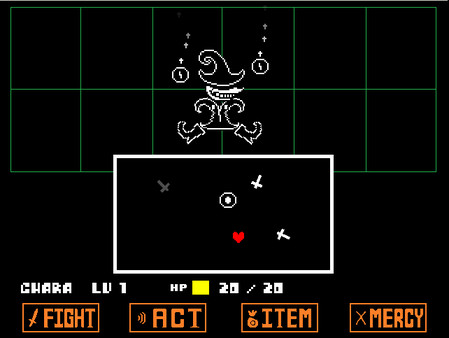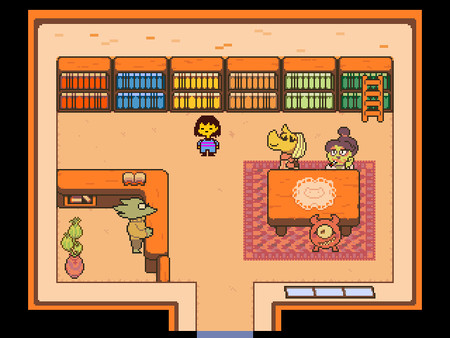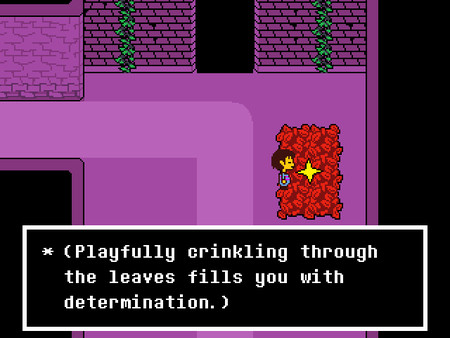
Undertale – Game Club Recap
This month we played one of the most talked about and hyped indie games in recent memory — Undertale. Undertale on its surface is a throwback to the 16-bit heyday of SNES RPGs, with graphics, gameplay, and audio to match, but as the name suggests, there’s a lot more going on beneath all of that. Undertale is a bit of a surprising success given that it doesn’t have the usual hallmarks of an indie mega-hit — it lacks the rogue-like elements, procedurally-generated levels, endless replayability, or survival elements that tend to dominate the genre these days. What it does have is a heavy dose of nostalgia for the 16-bit era of video games, both celebrating and poking fun at the tropes of RPGs from that time. In fact one of our group commented on how long the game-over/restart process takes, but that may just be a byproduct of being used to games designed for massive amounts of repetition.
 There is a lot to like about Undertale, from its perfectly scored chiptunes soundtrack that sounds both modern and like it could have been the soundtrack for any number of classic SNES games, to its take on turn-based battle systems that encourages the player to learn about their enemies and find creative solutions for dealing with them. Each new encounter is a unique experience unlike anything we’re used to seeing in this type of game. Although enemy encounters are random as you explore the 2D game world, which was one thing we weren’t thrilled about, the encounter rate is fairly low and the interactions different enough that it doesn’t feel tedious. The encounters themselves have two parts: an interaction phase that allows the player to take some action, and then the monster attack phase that is essentially a miniature bullet-hell shooter that matches the personality of each enemy.
There is a lot to like about Undertale, from its perfectly scored chiptunes soundtrack that sounds both modern and like it could have been the soundtrack for any number of classic SNES games, to its take on turn-based battle systems that encourages the player to learn about their enemies and find creative solutions for dealing with them. Each new encounter is a unique experience unlike anything we’re used to seeing in this type of game. Although enemy encounters are random as you explore the 2D game world, which was one thing we weren’t thrilled about, the encounter rate is fairly low and the interactions different enough that it doesn’t feel tedious. The encounters themselves have two parts: an interaction phase that allows the player to take some action, and then the monster attack phase that is essentially a miniature bullet-hell shooter that matches the personality of each enemy.
Personality is a key element to the game, and we all agreed that the writing really shines in this aspect as story elements are integrated into the game world for the player to discover. Little details like the main NPCs all having unique speaking fonts and the sound design that match their personalities really make them memorable when encountered repeatedly throughout the game. Each enemy also has its own distinct characteristics and personality that the player is encouraged to discover more about in order to progress through more difficult encounters. Humor is central to Undertale, with much of it aimed squarely at the games it was inspired by. There is also much humor to be found in random small moments in the game that may not be central to the story, but fit perfectly with the tone of the game, and make it a far more memorable experience that brings the game world alive.
 We were a bit split on the art style of Undertale. The enemies are all memorable, unique and well-drawn mostly monochromatic line art representations of the many whimsical creatures you will encounter on your journey. We felt that the main character’s sprite was a bit too muddy for our tastes and at times felt out of place looking like an 8-bit character in a 16-bit world. The identity of the main character is meant to be somewhat ambiguous, but we felt that since it is the piece of art you spend the most time looking at in the game, it could have been a bit more aesthetically pleasing. That is not to say that it is a huge detraction from the experience — it just could have been better. The environment art also varies quite a bit, with some gorgeously drawn sprites really adding to the experience, and some looking like they could have been in an Atari game. So consistency is a bit of an issue with the art; not enough to really detract from the experience, but just enough to be noticeable.
We were a bit split on the art style of Undertale. The enemies are all memorable, unique and well-drawn mostly monochromatic line art representations of the many whimsical creatures you will encounter on your journey. We felt that the main character’s sprite was a bit too muddy for our tastes and at times felt out of place looking like an 8-bit character in a 16-bit world. The identity of the main character is meant to be somewhat ambiguous, but we felt that since it is the piece of art you spend the most time looking at in the game, it could have been a bit more aesthetically pleasing. That is not to say that it is a huge detraction from the experience — it just could have been better. The environment art also varies quite a bit, with some gorgeously drawn sprites really adding to the experience, and some looking like they could have been in an Atari game. So consistency is a bit of an issue with the art; not enough to really detract from the experience, but just enough to be noticeable.
 Some of our issues with the game came from the moment-to-moment gameplay. The boss battles can have somewhat obtuse solutions that can be brute-forced by players with enough patience. The puzzles in the early part of the game felt a bit too easy and not very puzzle-y, and after a while the random enemy encounters felt a bit like grinding without much of a tangible reward in the typical game sense. Undertale doesn’t necessarily rely on its moment-to-moment gameplay to make it a compelling experience, however, and almost excels in spite of it. There are enough unique elements to the game to make it feel both familiar and new to fans of old school RPGs.
Some of our issues with the game came from the moment-to-moment gameplay. The boss battles can have somewhat obtuse solutions that can be brute-forced by players with enough patience. The puzzles in the early part of the game felt a bit too easy and not very puzzle-y, and after a while the random enemy encounters felt a bit like grinding without much of a tangible reward in the typical game sense. Undertale doesn’t necessarily rely on its moment-to-moment gameplay to make it a compelling experience, however, and almost excels in spite of it. There are enough unique elements to the game to make it feel both familiar and new to fans of old school RPGs.
For some people, the hype surrounding Undertale may be too much, and the game taken at face value could fail to live up to its expectations — especially during the season of major triple-A releases flooding the market with the promise of revolutionary graphics and gameplay. However, we still contend that Undertale is worth playing to surprise and challenge your own expectations as a player.